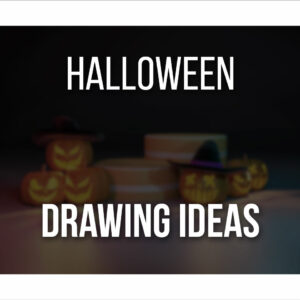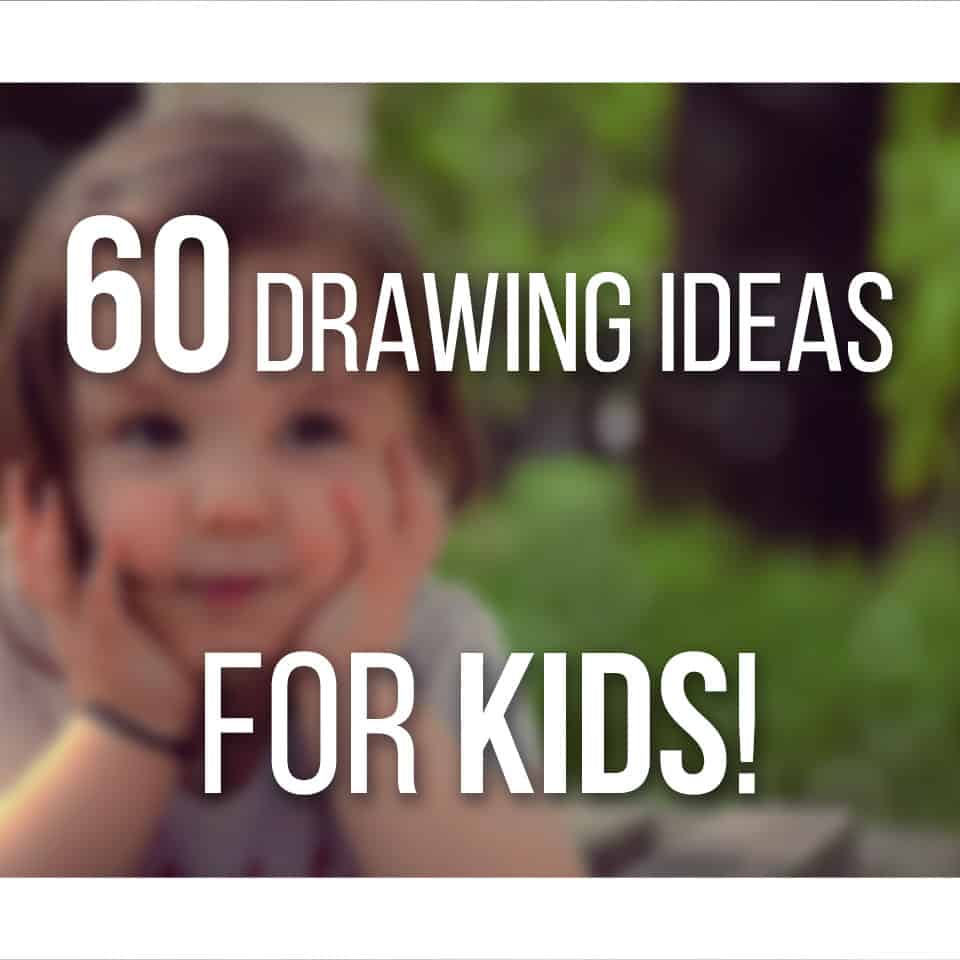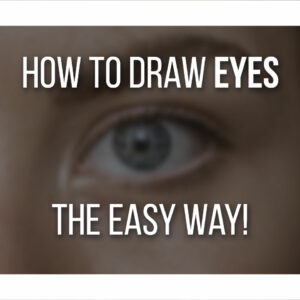Even though I tend to draw very peaceful-looking characters in most of my pieces, I like to play with emotions and take some time to do some fun exercises. The more exaggerated, the better, and you can play a lot with angry expressions!
Let’s go over, step by step, how to draw an angry expression so that in the end, you can draw your character looking furious and be able to play even more with drawing angry expressions!
Table Of Contents
- 1 Drawing Emotions using the Eyebrows
- 2 Larger Eyes Makes Angrier Faces And Expressions!
- 3 Drawing the Iris Of An Angry Face
- 4 An Angry Mouth For An Angry Face
- 5 Complement the Angry Face with Details!
- 6 Consider Using Angry Colors For Your Angry Face
- 7 Drawing an Angry Face From the Side
- 8 Drawing a Simple Version of an Angry Face
- 9 Summing it Up
Drawing Emotions using the Eyebrows
As with drawing any face (as we have in our complete guide here), the expressions are super important to convey correctly!
When drawing any expression, the eyebrows can do most of the work here!
Not sure where to start with the Emotion?
Draw the Eyebrow! Exaggerating the curves of your eyebrows can change a lot in the expression of your character.
Try putting yourself in front of a mirror and studying your reflection.
As you go from expression to expression, you’ll notice that in every single one of them, the eyebrows play a huge part in emphasizing it!
There are a lot of artists and animators that work with a small mirror on their desks.
This way, they can test and watch their reflections as a reference when drawing their characters.

If you have a small mirror at home, try and do the same: sit at your desk for around 30 minutes or one hour and practice expressions while using yourself as a reference!
Another option is to look up on the internet some images and make your studies from there.
Remember, when sketching up and drawing, to try and exaggerate the expressions and your lines, it gives more personality and a different motion to your drawings.
Of course, there’s the last option, that’s a mix of both of these!
Take photos of yourself or a friend.
If jumping between drawing and looking at a mirror seems too complicated, or you can’t just a reference image good enough. Then, take a picture of yourself or ask for a friend to pose for you!
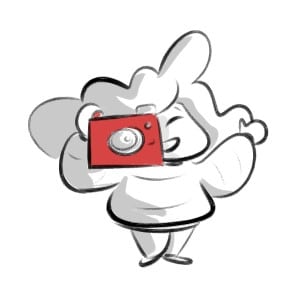
So let’s start with our eyebrows first:
Tilting the Eyebrow helps a LOT when trying to convey angry emotions.
Simply tilt it towards the nose, making a very slanted line, with the outside tips going away from the eyes.
The more you tilt them, the more exaggerated your expression will be.
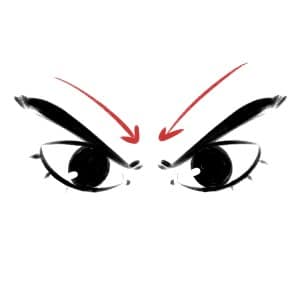
Of course, if you want a more passive angry face, drawing the eyebrows really close to the eyes to the job. If you want the expression to be very flat but still judgy, draw them almost straight and on top of the eyes.
Once again, the tilted you make them, the angrier it will look like, so it’s up to you how you want to convey your character’s emotions!
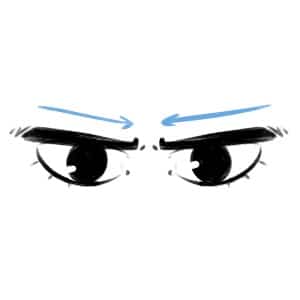
Larger Eyes Makes Angrier Faces And Expressions!
As a general rule, the larger the eye the more emphasis it gives to the expression.
It doesn’t matter what kind of shape you’re drawing the eyes with, but the bigger you do them, the angrier your character looks.
It’s the difference between being angry and furious.
This also works with other emotions: simply scared to terrified, sad to agonized, surprised to astounded and so on.
The size of the eye works like a balance for your emotions.
The bigger, the more emotional it is. So when you’re making Angry Eyes and want that extra boost of expression, increase the overall size of the eye. This will make it look extra angry.
In the images below, I give you two examples, one of them you can see that the eye has a very regular size and the other I exaggerated it a lot, making them really big.
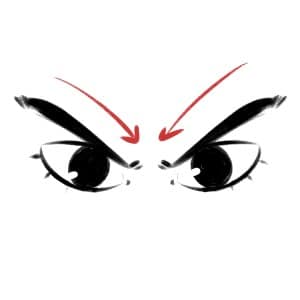
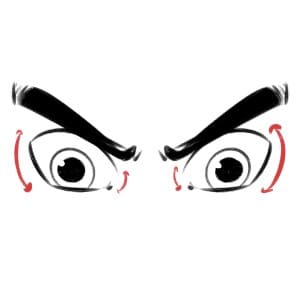
Try out both ways and even some other eye sizes in-between so you can really understand the differences, by practicing.
You can even make your drawings, all side by side, scaling them up so you can use it for reference whenever you want to draw angry characters!
Drawing the Iris Of An Angry Face
We’ve talked about the size of the eye, let’s now talk about yet another important element when drawing expressions: the iris!
When drawing the iris you should draw it small for an angrier expression.
The contrast between a small dot for the iris and a vast white around it, speaks to us, visually, of urgency, panic, and even lunacy.
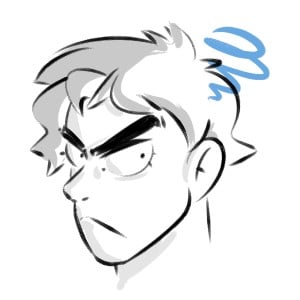
The size you decide for the iris can make your character look like a real psycho or someone that has completely lost their mind.
For example, someone who’s so angry that is way past any kind of logic and reason.
Drawing it too big, can make it look like the character isn’t phased at all with what happened, which is also something you can make use of.
A character that is beyond human emotions or a very evil character that doesn’t really care what’s happening and how much destruction they cause.
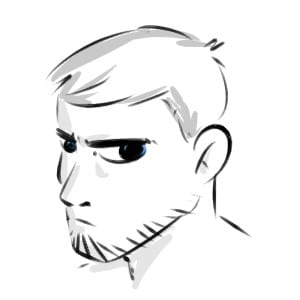
Once again, you can make the same kind of exercise as before, draw the eyes with different iris sizes, scaling them up and compare each other and how they feel.
Other than the iris, you can also play with the eyebrows and eye size.
Mix and match them and see how many different results you can get!
An Angry Mouth For An Angry Face
Mouths have feelings too!
Well.. kind of.
You can’t draw an expression with merely the eyes, the rest as to show the emotion as well, a wrinkled nose goes very well with the angry eyes for example!
The mouth also plays a big role when drawing any kind of expression. One of the easiest ways to express an angry attitude with the mouth is to show some teeth.

Like we talked before, simply try to get angry at the mirror and say something, you’ll notice how your teeth tend to show when you’re angry.
On another note, an angry *grr* kind of expression almost like a dog works wonders.
The curve of the mouth and its size are two other very important aspects to pay attention to. Depending on it, the way you read the emotion can change a lot!
Let’s pick an example, surely you’ve seen some Batman movies, series, and comics.
Surely you’ve seen the iconic Joker even if it was in a mug or t-shirt.
His character is a great example when talking about expressions.
He’s very expressive and exaggerated. We know he’s completely mad and there’s no reason left in him, but we don’t know this merely by his actions, every tiny visual detail tell us that!

In a state of pure malice, Joker’s face will appear angry, with very tilted eyebrows, big eyes, a tiny dot for an iris and finally, a very opened, big mouth, tilted upwards.
You can tell by the way the mouth curves, he’s obviously enjoying his hostility and his “pranks”.
So if you’re not sure how to draw a character who enjoys how evil they are, Joker will never fail you, look up some comics and you can find a ton of references from it!
Let’s take another example: Guts, from Kentaro Miura’s famous manga Berserk, is the perfect example of an angry character. An example of someone who turned to anger to find the strength to survive and fight.
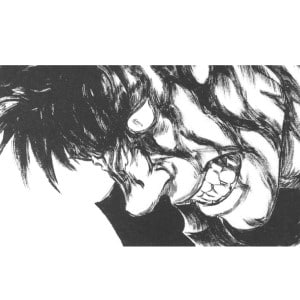
His mouth, often curves downward, angry, frustrated and when furious his mouth will be drawn opened, showing a lot of teeth, but this time, as oppose to Joker, it tilts upside down.
Guts isn’t completely out of his mind, all out of reasoning. Nor does he enjoy it.
No, he’s in pain and he’s furious, but still very much conscient of his own actions (for the most part, but that’s a whole other matter!).
So from this two examples, you can clearly see how you can play with the mouth to change the tone of the emotions you want to portray and how it has such an important role in drawing an expression as the eyes!
Complement the Angry Face with Details!
It’s all about the tiny details!
If you’ve done all the steps and still want to add a little more “oomph” to the face, focus on the details! When drawing a face and expressions, the whole face responds to the emotion.
Wrinkles tend to show around the eyes, nose, and mouth.
Same goes with the eyebrows when they grow very close together. Again, try and make a very angry face at your mirror and look at all the lines that appear around your face!
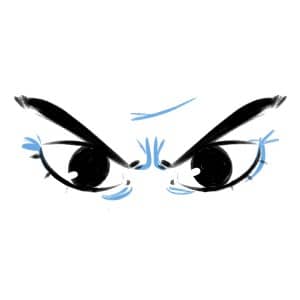
If you want to go really overboard with it, you can add some gleam to the eyes or some bits of saliva connecting the teeth and even a tongue showing up!
Once again it’s all about experimenting and trying new things, go completely overboard with it. Think of a character, but before drawing it, think about their traits:
Let’s say I want to draw a vampire, hungry for blood, insatiable.

Another example, a very simple one: my character, a very tired student, dropped a plate, full of food on the floor.

Two very opposing types of characters!
Write down ideas, play out different sceneries for your character and sketch them out, this is a good way to practice your expressions and to leave them more dynamic!
Consider Using Angry Colors For Your Angry Face
And contrast!
Color is very important when drawing. You’re not just adding it to your drawings or to your characters.
You’re telling something with it.
Even if it’s just to transmit calm and a sense of balance to the viewer, you’re still talking through the colors you used.
You can also use colors to convey emotions. Red is the color most used to show rage, but some oranges, purple and even yellows also work very well! (And if you’re need of some coloring tools, here you go)
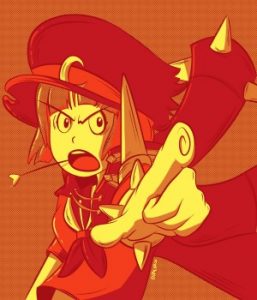
A very good example of the use of color to portray emotion is Disney Pixar’s movie Inside Out!
This is a very interesting movie about emotions and how important they are. They do an amazing job showing that in a very lighthearted and fun way, but also through the color!
Notice how each emotion has a specific color.
Not only the ones inside the main character but all the other emotions, belonging to the other characters.
Inside everyone, Joy is yellow, Sadness is blue, Fear is purple, Disgust is green and, the most important one for us here: Anger is red!
Each one also has a different weight and sign of importance, depending how much of that emotion the person feels and how much it guides their lives.
This does not mean, that feeling one more than the other is inherently bad, just that it’s part of us and our growth.
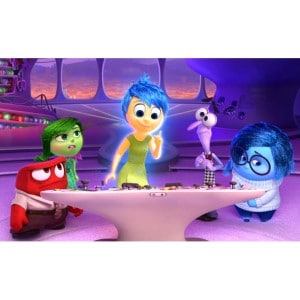
If, in your painting, you want to portray this emotion and want to go all out with it.
If this is the main subject of it, then take the chance to go all the way. Not only you’re giving an extra boost to the emotional state of the character, you’re also using color to your advantage.
People feel whatever emotion a painting is trying to convey, not only from the lines but through the way you worked with the colors!
It all depends on what you want to go for. If you really want to exaggerate, go with something very vibrant and chaotic.
Going to the limit can be a risky maneuver sometimes, but also a good choice.
If you’re 100% sure that’s how you want to transmit your message, other people will be able to read it that way as well.
As for contrast, this is also something to have always in account.
Not only in a colored piece but in a black and white one. Especially in the latter!
If all of the painting as the same weight, the eyes of the viewer will get lost and lose any focus. It also makes the painting flat.

Play with contrast.
Give some parts of your painting more emphasis than others. Be it either with extra shadows, big masses of strokes or giving vibrant colors to parts of it, while others are softer.
Play with different palettes and different kinds of strokes and weights.
Balance your paintings not only through the drawing but color as well. Look up different colors and their meanings.
Each emotion can be conveyed through a color.
And if the emotion itself is the most important part of your painting, by assigning the right color to it, you’ll give it an extra something!
Drawing an Angry Face From the Side
When drawing an angry face on a side view, the same principles apply.
In fact, it can even be easier! Instead of drawing the whole face, you’re basically drawing half of it.
You still need to pay attention to how you draw the face, though. Think about perspective and 3D.
Even though you’re drawing a 2D piece, you have to give shape to it, portray the idea of 3D.
A head, body, and face have volume.
And drawing them in a side view can be a bit confusing at the beginning and hard to give that volume.
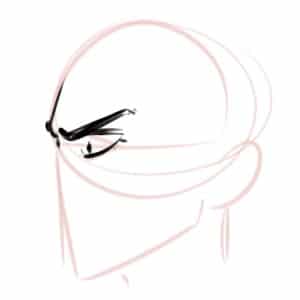
The biggest change you’ll notice is how you draw the eye.
This time we draw it in a cone shape. When drawing it in front view, we tend to draw an almond shape. Now, you need to learn to draw your eye differently.
You can still give different shapes and styles to the eye. But the positioning will change and it will always have the same base cone shape.
If you remember this, you won’t have any trouble drawing the eyes!
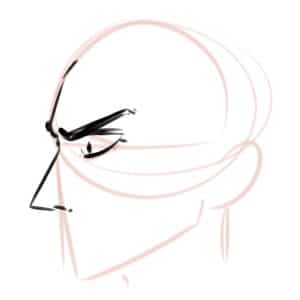
The nose will also have a very different part here.
In a front view, the nose can be almost non-existence. Very simple. Two dots above the mouth and you wouldn’t need much more.
On a side view, it’s quite the opposite.
The nose here is very prominent and a big part of the head shape itself.
Once again, you can still play with styles and sizes of the nose, but it takes a more important role in the drawing.
The base shape for your nose will maintain though. So as long as you keep that triangle shape in mind, you’ll do good!
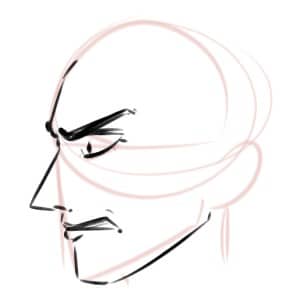
The mouth itself, won’t be as problematic.
It’s one my favorite things to draw in a side view, especially if it’s an angry face!
Everything else: tilted eyebrows, close to the eyes.
Big eyes, with very small irises to exaggerate the expression and wrinkled noses still apply here.
Remember you can always take photos of yourself to help you better get a reference image, or use reference images online. It really helps!
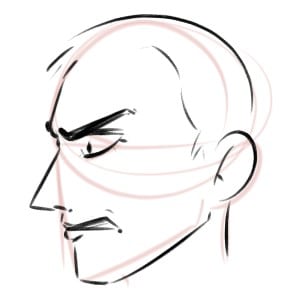
You can find more Face Drawing Tips here!
Drawing a Simple Version of an Angry Face
Sometimes, less is more!
You don’t need to go with a very complex drawing right away.
Why don’t you start practicing with a stickman?
It’s all shapes, and all the principles apply here as well.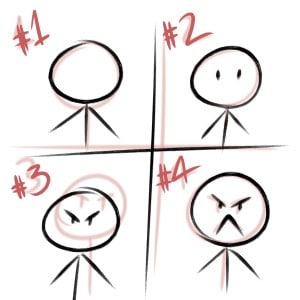
This is a very minimalistic look but it can work, if you’re going for that and if that’s the style you’re going for.
I’ve seen some stickman comics that can portray the emotion in a better way, than with something very complex. It’s all about what you want and like.
If you want something raw, going with a simple style like this can work wonders!
Sometimes, if you add too many details, it can take away the initial emotion that you’re going for and its meaning.
It’s also a great way for you to practice and learn.
Before going to the big, complex drawings, try out your expressions with very simple and basic shapes like this!
Once you nailed those, you can just apply it to more complex drawings.
Summing it Up
The secret, as always, to improve and discover new ideas and styles is to have fun and experiment a lot!
There’s a lot of emotions you can play with.
Start with the eyebrows, then the eyes and mouth. Try different sizes, curves, and details. Make a sheet with a scale with different kinds of angry expressions.
This will help you both in your progress as an artist, but also you now have a reference sheet for you to look at whenever you need to pick one angry face.
And remember to use references!
You can’t learn without looking and observing what you want to draw. Look up on the internet for different angry expressions or make them yourself in front of a mirror.
Study and sketch them out.
If you find it too hard to keep looking at yourself and then your drawing over and over, take a selfie!
Goof up with your camera and take pictures of yourself for future reference!
And if you want to learn more about Drawing The Entire Head, check out my article here.

Patricia Caldeira is the main writer here at Don Corgi. She's an art teacher with over 20.000 happy students across many platforms and courses!
Enjoy your stay and as always:
Keep on drawing!
